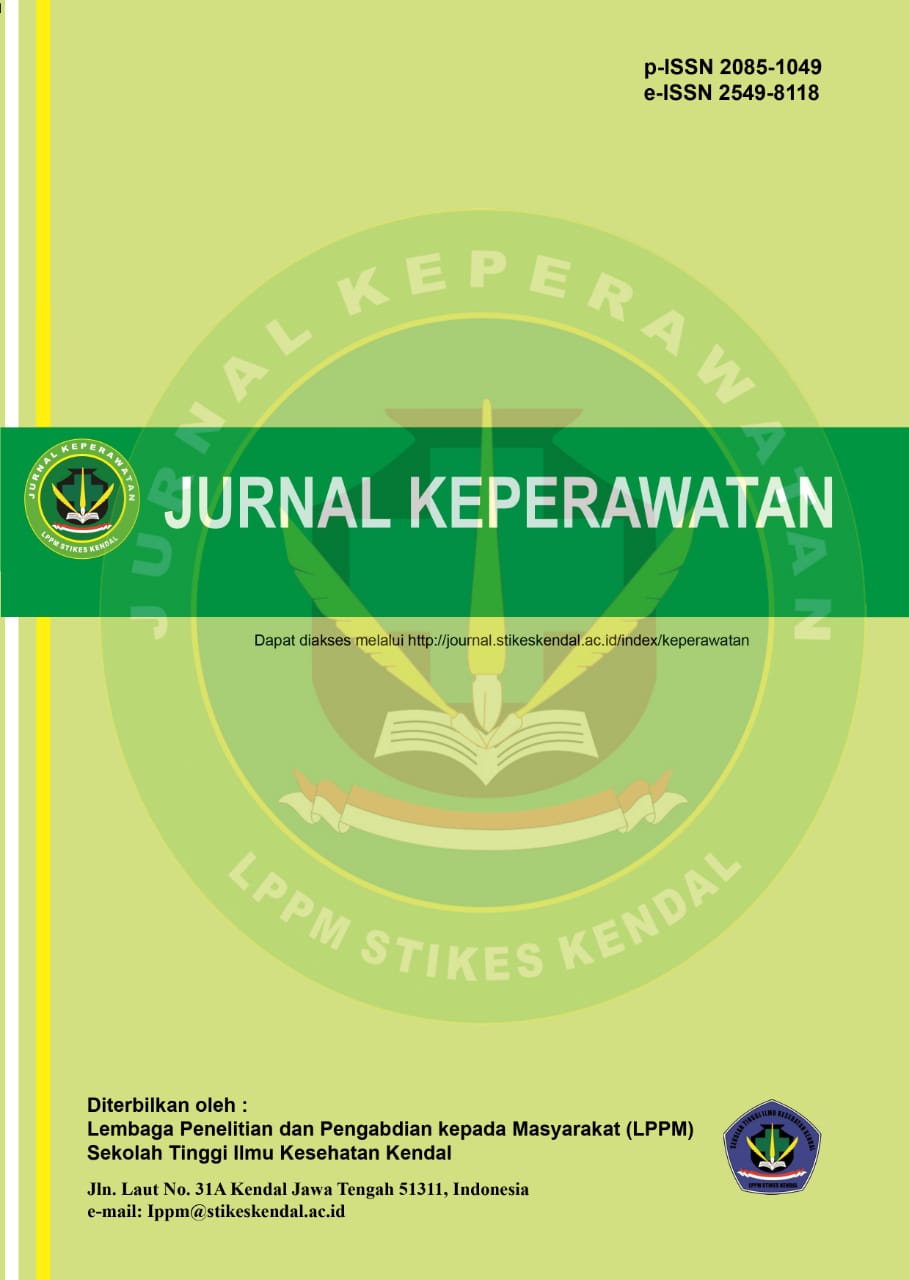Intervensi Lima Kegiatan Hidup Sehari-Hari (ADL) Meningkatkan Fungsi Independen Pasien Stroke Iskemik
DOI:
https://doi.org/10.32583/keperawatan.v15i3.572Keywords:
aktivitas hidup sehari- hari (adl), fungsi kemandirian, hemiparesis, stroke iskemikAbstract
Stroke berdampak pada kecacatan fisik antara lain hemiparesis yang menggangu aktivitas sehari- hari serta berdampak pada fungsi kemandirian pasien. Penelitian bertujuan untuk mengetahui pengaruh intervensi activity day living (ADL) terhadap tingkat kemandirian pada pasien stroke iskemik. Desain penelitian ini quasi ekspriment dengan control groups pretest-post test design. Responden diambil secara consecutive sampling sebanyak 16 pasien stroke iskemik di ruang rawat inap di RSUD A.W Sjahranie Samarinda. Data dikumpulkan dengan lembar instrumen aktivitas ADL. Alat ukur menggunakan modifikasi Indeks Barthel valid dan realible oleh Supraptiningsih (koefisien Kappa 0,70). Analisis data menggunakan paired t test, uji wilcoxcon test, mann whitney u test, Independent T Test. Hasil penelitian menunjukkan bahwa sesudah dilakukan intervensi, peningkatan skor tingkat kemandirian kelompok intervensi dari 60.00±17.53 menjadi 70.00±14.14, sedangkan skor tingkat kemandirian kelompok kontrol dari 55.00±9.26 menjadi 56.88±9.61. Setelah diberikan intervensi activity day living (ADL) significant adanya perbedaan skor kelompok intervensi dan kontrol pada tingkat kemandirian (p<0,05). Intervensi activity day living (ADL) terbukti meningkatkan kemandirian pasien stroke iskemik. Pemahaman, pengulangan, tindakan segera akan mempercepat penyembuhan, serta bisa sebagai intervensi keperawatan di rumah sakit.
References
Alia, C., Spalletti, C., Lai, S., Panarese, A., Lamola, G., Bertolucci, F., … Caleo, M. (2017). Neuroplastic Changes Following Brain Ischemia and their Contribution to Stroke Recovery : Novel Approaches in Neurorehabilitation. 11(March), 1–22. https://doi.org/10.3389/fncel.2017.00076
Alison, A., & Hunter, S. M. (2015). Optimising rehabilitation potential after stroke: a 24‐Hour interdisciplinary approach. British Journal of Neuroscience Nursing, 10(6), 242–246. https://doi.org/DOI:10.12968/bjnn.2014.10.6.268
Andrianur, F. (2019). Dukungan Keluarga Sebagai Caregiver Pada Aktivitas Hidup Sehari- Hari (Adl) Pasien Stroke: Literatur Riview. Seminar Nasional & Call For Papers “ Inovasi Pelayanan Penyakit Tidak Menular ,” 66–71. Retrieved from https://ejournal.poltekkes-kaltim.ac.id/index.php/prosiding/article/view/3/3
Andrianur, F., & Era, D. P. (2022). Level of Patient Dependence in Stroke Patients in Fulfilling Daily Activities ( ADL ). Post Covid-19 Pandemic The Future of Health Care (Opportunities and Challenges), 36–42. Retrieved from https://iconphp.poltekkesdepkes-sby.ac.id/index.php/iconph/article/view/49/46
Black, J. M., & Hawks, J. H. (2014). Keperawatan Medikal Bedah: Manajemen Klinis untuk hasil yang diharapkan. – Buku 3. (Edisi 8). Singapore: Elsevier.
CDC. (2020). Stroke Facts. Retrieved from https://www.cdc.gov/stroke/facts.htm
Cramer, S. C. (2018). Treatments to Promote Neural Repair after Stroke. Journal of Stroke, 20(1), 57–70. https://doi.org/https://doi.org/10.5853/jos.2017.02796
Darussalam, M., Shaluhiyah, Z., & Widjanarko, B. (2022). Rehabilitation Program in Improving ADL ( Activity Daily Living ): Literature Review. Jurnal Ilmu Kesehatan Stroke, 7(4), 1067–1074. https://doi.org/10.30604/jika.v7i4.1289
Karanjit, J. (2019). Status Of Upper Limb Activities Of Daily Living Among Stroke Patients. Faculty of Medicine University of Dhaka.
Kawamura, K., & Minegishi, S. (2022). Effect of a weekly functional independence measure scale on the recovery of patient with acute stroke. Medicine, 101(11). https://doi.org/10.1097/MD.0000000000028974
Kennedy, N. C. (2021). The role of neuroplasticity in stroke nursing. British Journal of Neuroscience Nursing, 17(Sup2), S20–S25. https://doi.org/10.12968/bjnn.2021.17.sup2.s20
Li, F., Gong, Q., & Lu, Y. (2022). Effects of continuous nursing on rehabilitation compliance , living quality and daily living ability of patients with acute ischemic stroke. 14(1), 381–388.
Maher, C. (2022). Activities of Daily Living After Stroke: How to Regain Your Independence. Retrieved November 6, 2022, from FlintRehab website: https://www.flintrehab.com/activities-of-daily-living-after-stroke/
Martini, S. (2021). Hati-hati! Kepandaian Bisa Menurun Pasca Stroke! Retrieved from http://news.unair.ac.id/2020/05/07/hati-hati-kepandaian-bisa-menurun-pasca-stroke/
NIH. (2014). Post-Stroke Rehabilitation. Retrieved June 9, 2015, from National Institute of Health website: http://stroke.nih.gov/documents/PostStroke_Rehabilitation_english_brochure.pdf
NINDS. (2022). Post-Stroke Rehabilitation Fact Sheet. Retrieved July 25, 2022, from National Institute of Neurological Disorders and Stroke website: https://www.ninds.nih.gov/post-stroke-rehabilitation-fact-sheet
Ohura, T., Hase, K., Nakajima, Y., & Nakayama, T. (2017). Validity and reliability of a performance evaluation tool based on the modified Barthel Index for stroke patients. BMC Medical Research Methodology, 17(1), 1–8. https://doi.org/10.1186/s12874-017-0409-2
Pollock, A., Se, F., Mc, B., Langhorne, P., Ge, M., Mehrholz, J., … F, V. W. (2014). Interventions for improving upper limb function a er stroke (Review). https://doi.org/10.1002/14651858.CD010820.pub2.www.cochranelibrary.com
Sakar, H., & Mahtab, A.-K. (2019). Iranian Version of Barthel Index: Validity and Reliability in Outpatients’ Elderly. International Journal of Preventive Medicine, 10, 130–130. https://doi.org/10.4103/ijpvm.IJPVM_579_18
Sato, A., Fujita, T., & Yamamoto, Y. (2017). Activities of daily living independence level for home discharge in stroke patients based on number of caregivers: an analysis of the Japan Rehabilitation Database. Journal of Stroke & Cerebrovascular Disease, 20(2), 23–27. https://doi.org/10.1298/ptr.e9914
Semachew, A. (2018). Implementation of nursing process in clinical settings : the case of three governmental hospitals in Ethiopia , 2017. BMC Research Notes, 4–8. https://doi.org/10.1186/s13104-018-3275-z
Su, F., & Xu, W. (2020). Enhancing Brain Plasticity to Promote Stroke Recovery. 11(October), 1–15. https://doi.org/10.3389/fneur.2020.554089
Sullivan, A. B., & Miller, D. (2015). Who is Taking Care of the Caregiver? Journal of Patient Experience, 2(1), 7–12. https://doi.org/10.1177/237437431500200103
Supraptiningsih. (1993). Reliabilitas modifikasi indeks barthel pada penderita stroke. Yogyakarta.
Ting, W. K., Fadul, F. A., Fecteau, S., & Ethier, C. (2021). Neurostimulation for Stroke Rehabilitation. 15(May), 1–11. https://doi.org/10.3389/fnins.2021.649459
Wang, J., Chen, Y., Zhang, Y., Li, M., & Jin, J. (2020). Rehabilitation nursing for motor functional recovery of acute ischaemic stroke : study protocol for a randomised controlled trial. 1–8. https://doi.org/10.1136/bmjopen-2020-037391
Whitiana, G. D., & Cahyani, A. (2017). Level of Activity Daily Living in Post Stroke Patients. Althea Medical Journal, 4(2), 261–266.
WHO. (2019). Health Topics: Stroke, Cerebrovascular Accident. Retrieved from World Health Organization website: http://www.who.int/topics/cerebrovascular_accident/en/
Downloads
Published
How to Cite
Issue
Section
License
Copyright (c) 2023 Jurnal Keperawatan

This work is licensed under a Creative Commons Attribution-NonCommercial-NoDerivatives 4.0 International License.




